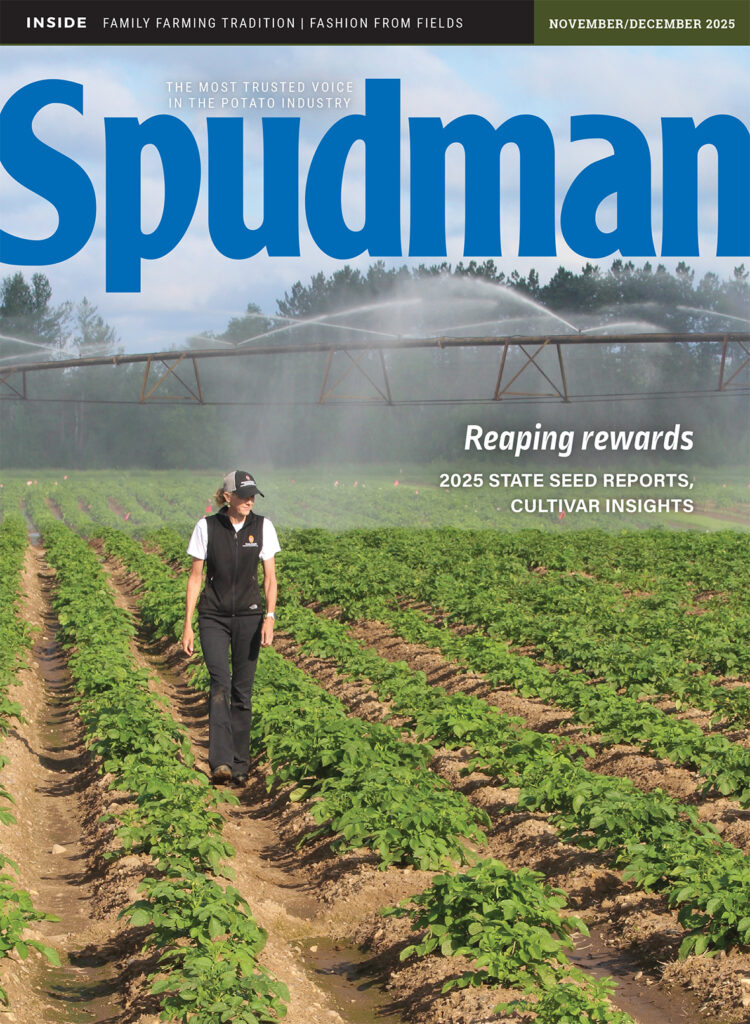Going Underground
Many agronomic crops have benefited from subsurface drip irrigation (SDI), including cotton and corn, but potatoes primarily rely on pivot and sprinkler irrigation systems. Research across the United States has indicated that potatoes also can increase productivity with SDI, including alternative uses of the system, to help growers implement water conservation strategies.
One of the factors behind the slow adoption of SDI systems in potato fields is cost. SDI systems are much more expensive than sprinkler systems.
They use it for other crops, but not for potato. It’s less expensive per acre to irrigate using sprinklers,” said Clint Shock, director of the Oregon State University Malheur Experiment Station, Ontario.
Shock has conducted research in potato irrigation, including with SDI. “Usually, growers aren’t reluctant to do one thing or another. They are rational, so they make decisions on what works functionally,” he said.
Another factor lies in climate and geography, which can provide advantages for each system.
“If you’re in an area where maybe it’s too cool or wet for potatoes, than SDI’s a good fit because the ground stays drier, there’s less disease pressure,” Shock said. “Sprinkler irrigation is an advantage for cooling off the crop, so if you need to cool your crop, sprinkler irrigation is a lot less expensive per acre.”
Through research at the Malheur Experiment Station, Shock has seen the benefits offered through SDI, but the cost of the system still limits its use in potatoes.
“In drip systems, you have more effective application of water and nutrients, and you don’t provoke as much environmental pressure to cause fungus or late blight,” he said. “We’re able to grow superior yield and quality with drip than other systems. On potatoes, we can grow better crops and slightly higher yields, but it doesn’t compensate the cost for the system.”
Florida potato growers have also been slow to adopt the system, much of which also relates to economics.
“Out here in Florida, it would be different than what we would expect for other states,” said Lincoln Zotarelli, University of Florida Vegetable Production specialist. “We have mostly chip potatoes and some table stock potatoes. What they have with revenue wouldn’t pay for the cost.”
Zotarelli has performed SDI research in potatoes for about five years, including at the Florida Partnership for Water, Agriculture, & Community Sustainability at Hastings.
Zotarelli said that another reason that SDI isn’t being adopted by Florida potato growers is the short growing season. From planting to harvest runs about 100 days. He said that Florida growers were not producing enough to justify the investment in SDI.
Florida growers rely mostly on seepage irrigation, which takes advantage of the high water table to water the crops. Because water is already near the root zone, SDI is less practical.
However, there have been some growers who have found a use for the system to help raise the water table, increasing the effectiveness of seepage.
“SDI (in Florida) is not like you see for other crops where you apply water down to the crop,” Zotarelli said. “SDI is used to raise the water table, so it’s kind of a hybrid between SDI and seepage. There is a potential for water savings about 30 percent over seepage.”
Installing SDI systems to supplement seepage irrigation does save costs, as fewer drip tapes are needed to raise the water table.
“The SDI water table management would use much less drip tape because every 16 rows, you have three tapes, so one tape would feed about five rows,” Zotarelli said. “It would benefit (growers) because the growers have the ability with SDI to raise that water table more uniformly. With SDI, you can achieve the same yield and have benefits of fertigation, but it’s still cost-prohibitive at this point.”
University of Florida researchers have recently started a new project to test several irrigation systems, including SDI, pivot and sprinkler, but previous research on SDI alone has proven it is ineffectual in Florida.
“We tested installing the drip tape two inches below the seed bed, and because of the sandy soil in Florida, it didn’t go over very well. The SDI for water table harvest has been installed 18 inches below the root zone,” Zotareli said.
Recent irrigation improvements have seen a new cross between SDI and overhead pivot systems, allowing producers to convert their existing overhead systems to SDI. T-L Irrigation is one of the companies that developed the technology. T-L is calling their product Precision Mobile Drip Irrigation (PMDI).
PMDI attaches drip hoses to the sprinkler drops, which are dragged over the ground. What made the technology functional is a special water emitter, developed by SDI manufacturer Netafim. The emitter is larger than standard sizes, releasing four gallons per hour to spread the water over a larger area. The hoses have optional spacings of 30 inches, 40 inches or 60 inches
“With PMDI, it’s an LEPA (low energy precision application system), but it spreads out the water so it’s taken into the ground and makes it valuable in any terrain,” said Dave Thom, T-L Irrigation vice president of sales.
The company has tested the system with many crops. There are no statistics for how it would function for potatoes, but the company is optimistic it can provide benefits to many produce crops.
“Some vegetable crops don’t want water on the fruit or leaves for fungus or other problems, and this works good for that,” Thom said. “Another benefit is we have a dry wheel track. Water is getting more and more valuable, and you have to do anything to get the most value out of it.”














